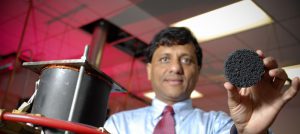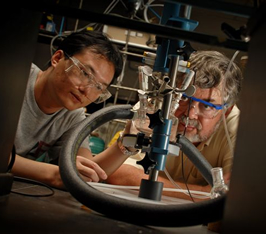Researchers Developing Tomorrow’s Energy Systems Today
By Mary Wymer
Energy is often defined as the capacity to do work. It exists in many forms, including kinetic, thermal, electromagnetic, chemical and nuclear, as well as sound and light energy.

While one energy form may be transferred to another, the total energy remains the same. So, most energy research efforts are aimed at improving efficiency and better harnessing energy.
From chemists to physicists to engineers, researchers throughout The University of Alabama campus are working to develop systems designed to reduce harmful emissions, produce new ways to harness energy, improve efficiency and increase fuel flexibility. These interdisciplinary research teams are working with major funding agencies, including the National Science Foundation, the U.S. Navy and the U.S. Department of Energy.
Energy projects have the potential to change the way we work and commute and to modify some of our other daily activities. UA’s teams of energy researchers are developing tomorrow’s energy systems, such as those used in fuel cell vehicles and those employing portable power, with a cleaner and more efficient future in mind.
The following are select samples of some of the energy-related projects underway.
Clean Combustion
Working on a porous inert media combustion concept, Dr. Ajay Agrawal, the Robert F. Barfield Endowed Chair in Mechanical Engineering, and his team are researching fuel flexibility without compromising emissions. The project is investigating how various types of fuel, such as diesel, natural gas or biodiesel, react within the porous material. This material is extremely strong but also very permeable, and it allows the fuel and air combustion to occur cleanly and efficiently.
“In our laboratory experiments, we are able to operate the combustor over a wide range of air and fuel flow rates while reducing noise and emissions,” says Agrawal.
So far, the project team has received promising results of quieter and cleaner combustion with the promise of a fuel flexible system. Agrawal has applied to patent this new technology.
Agrawal’s team is taking what they have learned from the porous inert media combustion project to develop a miniature combustion system for portable power needs. By converting thermal energy into electricity, the burner system could be used to generate power for small devices and personal electronics.
“This project could lead to replacement of batteries, especially for military usage,” says Agrawal. “Liquid fuels, such as JP-8, can store up to 100 times more energy compared to today’s batteries. Researchers in the field have been challenged by the need to cleanly and efficiently burn liquid fuels in a miniature combustor, a task we have accomplished recently.”
In addition to these combustion projects, Agrawal’s team is actively researching the combustion of bio fuels, such as biodiesel for electric power generation. In particular, the team is investigating combustion systems of advanced gas turbines for alternative fuel usage without causing adverse emission effects.
“Our experiments show that the biodiesel provides a good replacement for diesel fuel in gas turbines,” says Agrawal. “Because of the increasing price of biodiesel and its competition with food supplies, we are also exploring biofuels, such as pyrolysis oil made from wood products, as an alternative fuel for gas turbines.”
Chemical Energy for Fuel Cells
Numerous UA scientists and engineers are researching ways to make fuel cells more efficient and effective. Chemists, physicists, and chemical, metallurgical and mechanical engineers have teamed on multiple projects investigating various areas of fuel cells.

A typical polymer electrolyte membrane fuel cell is two metal plates, known as bi-polar plates, separated with a thin polymer membrane that is coated on both sides with a platinum catalyst. The platinum coated membrane is usually referred to as a membrane electrode assembly. Hydrogen gas contacts the anode side of the membrane, and the gas is split by the catalyst into electrons and protons. The protons (positive Hydrogen ions) diffuse through the electrically insulating membrane to the cathode side. Unable to cross the membrane, the electrons travel to the cathode through an electrical circuit, producing power. Air is supplied to the cathode side of the membrane. When the air reacts with the diffusing protons and the returning electrons, water is formed. The carbon bipolar plates surrounding the membrane electrode assembly collect the electrons and direct the flow of gases in channels.
UA researchers have been actively involved with molecular modeling of catalysts for a better reaction. Dr. Heath Turner, a Reichhold-Shumaker assistant professor of chemical and biological engineering, was recently awarded a NSF CAREER Award for his work with Boron doping catalyst models. Typically, researchers perform numerous experiments and then report results. Turner, on the other hand, has been modeling Boron doping of carbon through computation theories and now the rest of the research team is experimenting with his modeling work, which has seen positive preliminary results.
In addition, UA researches have had significant findings for making and purifying the hydrogen on the anode side to start the reaction process. Dr. Alan Lane, professor of chemical and biological engineering, explains, “The cleaner the hydrogen is starting the process; the more efficient the reaction and energy results.”
Similar to the hydrogen project, other UA researchers are working with methanol instead of hydrogen, including studies of catalysts on the anode side of the fuel cell.
Many discoveries have been made through UA’s fuel cell work leading to better understanding of the electrochemical reaction about the carbon oxidation process. Fuel cell research projects will continue to be pursued through many of UA’s interdisciplinary research teams as the University’s knowledge base grows with this area that could soon replace power sources for appliances and vehicles.
Further Reading